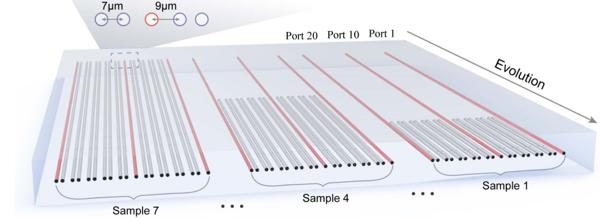Squeezed light is a key resource for quantum sensing and quantum information processing. Parametric frequency conversion in nonlinear crystals is an indispensable method to obtain non-classical light and generate multi-photon entangled states in quantum optics. Due to the inherent weak optical nonlinearity and limited interaction volume of crystals, considerable pumping power is usually required to obtain effective nonlinear interactions to produce squeezed light, but this often results in undesirable effects, such as damage to nonlinear materials.
In recent years, femtosecond laser direct writing technology stands out because of its flexible design and mask-free features. The waveguide structure can strictly bind the light field in the waveguide, and at the same time ensure the tight focusing condition and sufficient interaction volume, which significantly increases the intensity of nonlinear interaction.
In general, in order to build large-scale quantum systems capable of multi-photon manipulation, various functional modules must be integrated on a single chip. However, the manufacturing defects of waveguide and the evanescent wave coupling effect will lead to transmission crosstalk between different functional modules. This crosstalk not only changes the quantum state of the photon emitted by the light source, but also reduces the production efficiency and other properties.
Topological phases can protect physical fields from disordered disturbances, and this effect is at the heart of recent studies on topological protection for various nonlinear optical processes, including photon pair generation. However, the above studies were only carried out at low photon numbers and did not explore topological protection of strongly squeezed light, despite the importance of squeezed light in quantum optics.
The research group led by Dr. Xian-Min. Jin, director of the Center for Integrated Quantum Information Technologies (IQIT) in Shanghai Jiao Tong university, realized a Topologically protecting squeezed light on a photonic chip. The research results are published in Photonics Research, Volume 10, No. 2, 2022 (Ruo-Jing Ren, Yong-Heng Lu, Ze-Kun Jiang, et al. Topologically protecting squeezed light on a photonic chip[J]. Photonics Research, 2022, 10(2): 02000456).
In this work, topological protection theory and femtosecond laser direct writing technology are combined to protect the performance and evolution of on-chip squeezed light source by designing specific topological structure and constructing topological phase. Topological protection of squeezed light is explored theoretically and experimentally by fabricating dimer waveguide arrays mapped to the Su Schrieffer Heeger (SSH) lattice in fused silica.
Theoretically, the band structure and localized state densities at different topological ports are calculated, and the evolution results of pump light at different evolution distances are simulated. The nonlinear process of four wave mixing for topological protection is demonstrated experimentally, which enables the squeezed light to be generated efficiently using the silicon dioxide chip.
The cross-correlation functions and squeezing parameters of different topological structures at different evolutionary distances are measured to prove the topological protection of strongly squeezed states. The results show that this topological protection is robust to wavelength changes of nonclassical states. The topologically protected light field satisfies both tight focus and sufficient interaction volume, which contributes to the construction of high-quality quantum squeezers in complex photonic circuits.
The results of this study open up a new way to promote larger scale and higher fidelity of full-chip quantum processors. By combining topological protection theory and femtosecond laser direct writing technology, large-scale reconfigurable multifunctional modules can be integrated on a chip without crosstalk. It can be used for future practical quantum information tasks such as Gaussian boson sampling and boson error correction. The application of on-chip squeezed optical topological protection technology brings new opportunities for large-scale quantum integrated photonics.

Fig.1 Schematic diagram of topological protection structure of squeezed light. There are three topological ports, which are divided into seven groups based on the evolution length.


